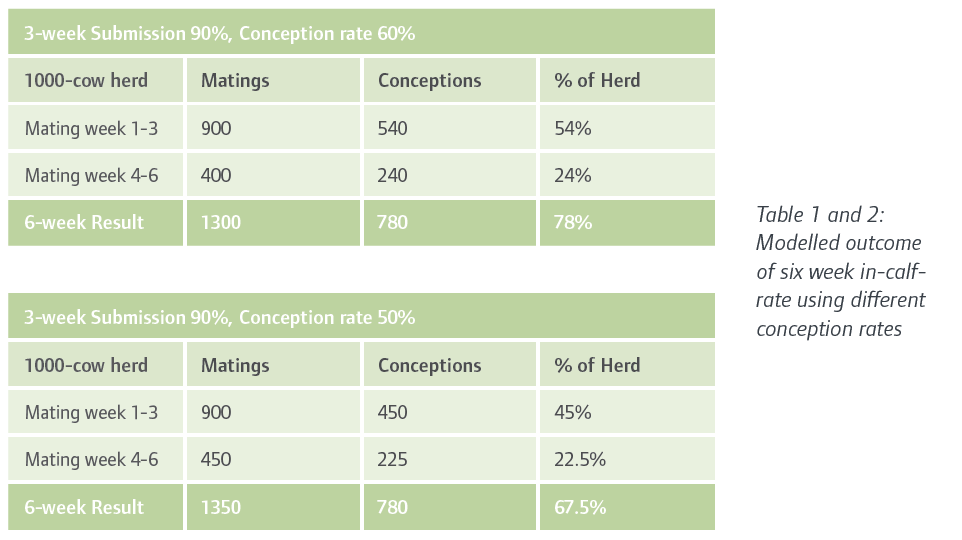For years, the approach to mating has been to apply heat detection aids sometime before mating starts, to monitor the heat activity and to then implement a strategy for anoestrus cows. This is a sound strategy which supports the good basic farming principles of calving cows early, optimising recovery and achieving high premating heat rates.
However, many continue to experience frustrating mating results. Despite many efforts to improve in-calf rates, the national mean 6-week in-calf rate still sits somewhere around 67% (New Zealand Dairy Statistics 2020-2021).
We are all aware of the 6-week 78% target. To get there, you must achieve a 90% 3-week submission rate and a 60% conception ate (CR) (Table 1). However, CR is closer to 50% for most – resulting in a 6-week in-calf rate around 67% (Table 2).

We have two ways of increasing our mating success, i.e. improving conception rates and/or increasing submissions.
Having focused mostly on the cows that were not cycling in the past, new thinking is emerging that gains could be made if we broaden our horizons: can we optimise mating results by managing our cycling cows differently?
Vetlife has been involved in an initiative in Tasmania (AUS), focusing on pulling as many cows forward to be mated as early as possible. The result is a higher rate of early matings and more matings overall, thus increasing the chance of higher in-calf rates, lower not-in-calf rates and more days in milk.
Using a synchronisation programme that starts only days from PSM and uses GnRH and PG only, entire herds were enrolled in a mating programme which resulted in up to 85% of the herd being mated in the first week of mating (Fig 1). It is worth noting that all cows were enrolled whether they had shown a premating heat or not (as long as they were 30-days calved) and they were mated to observed oestrus, either using collars or tailpaint as heat detection. CIDRs were used on Day 11 and FTAI was done on Day 21 of non-mated cows (2% of herd in example below):

Potential outcomes for a typical New Zealand dairy herd have been modelled below with a similar submission rate curve and one of two conception rates:


What is so extraordinary about that?
Firstly, premating heats were not observed in these herds and no specific targeted non-cycler treatment was performed. Secondly, these results are modelled to show that although conception rates are important, allowing cows more chances to conceive on a larger scale will ultimately result in higher in-calf rates, even if conception rates stay the same. Fig. 2 uses average conception rates very close to those currently observed in New Zealand dairy farms. This means that if you changed nothing other than the timing of first service in your herd, you could potentially make marked improvements in overall reproductive results.
It is always important to mention that the basics must be in order: BCS, feeding, minerals and low disease prevalence among other things. You must also be prepared for the potential of a high early in-calf rate (meaning many early calves and a higher feed demand in early spring). It would, however, also mean higher overall milk production with more days in milk for early calvers.
As your veterinary health care provider, we strive to provide the support and the solutions that are right for each individual client. If you are keen to discuss this article and how this could be applied to your farm, please get in touch with us.
